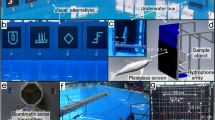Abstract
Man-made sonar has had limited success for object recognition because the echo waveform varies significantly with the location of the object within the acoustic beam pattern. The variation of the echo from the same object located in different parts of the beam is typically significant [1], This variation was minimized in previous experiments by careful placement of the objects in a stationary sonar field and by using objects that are large compared to the wavelength and that have shapes (spheres, cubes, pyramids and cones) that exhibit very different scattering properties [2, 3]. The system described in this paper exploits the important biological principle of mobility by translating and rotating the sonar in order to standardize the view of the object by positioning it at a constant location. The sonar design is motivated by bats, whose ears react by rotating to the direction of the echo source, and by dolphins, who appear to move as if to position the object at a standard location in the beam pattern [4, 5, 6].
Access this chapter
Tax calculation will be finalised at checkout
Purchases are for personal use only
Preview
Unable to display preview. Download preview PDF.
Similar content being viewed by others
References
R. Kuc. Biologically-motivated adaptive sonar system. J. Acoust. Soc. Amer, 100(3):1849–1854, 1996.
J.M. Richardson, K.A. Marsh, D. Gjellum and M. Lasher. Acoustic recognition of objects in robotics: Determination of type, pose, position and orientation. In L. Kessler, editor, Acoust. Imaging, vol. 16, pages 613–620. Plenum Press, New York, 1988.
H.L. Roitblat, P.W.B. Moore, P.E. Nachtigall, R.H. Penner, and W.W.L. Au. Natural echolocation with an artificial neural network. Int. J. Neural Networks, 1:239–248, 1989.
P. E. Nachtigall and P. W. B. Moore. Animal Sonar: Processes and Performance. Plenum Press, New York, 1988.
J. A. Simmons, M. B. Fenton and M.J. O’Farrell. Echolocation and pursuit of prey by bats. Science, 203:16–21, January 1979.
W. W. L. Au. The Sonar of Dolphins. Springer-Verlag, New York, 1993.
R. Kuc. Biomimetic sonar recognizes objects using binaural information. J. Acoust. Soc. Amer, 101(8), 1997.
Author information
Authors and Affiliations
Editor information
Editors and Affiliations
Rights and permissions
Copyright information
© 1997 Springer Science+Business Media New York
About this chapter
Cite this chapter
Kuc, R. (1997). Biomimetic Sonar for Object Recognition. In: Lees, S., Ferrari, L.A. (eds) Acoustical Imaging. Acoustical Imaging, vol 23. Springer, Boston, MA. https://doi.org/10.1007/978-1-4419-8588-0_82
Download citation
DOI: https://doi.org/10.1007/978-1-4419-8588-0_82
Publisher Name: Springer, Boston, MA
Print ISBN: 978-1-4613-4640-1
Online ISBN: 978-1-4419-8588-0
eBook Packages: Springer Book Archive




